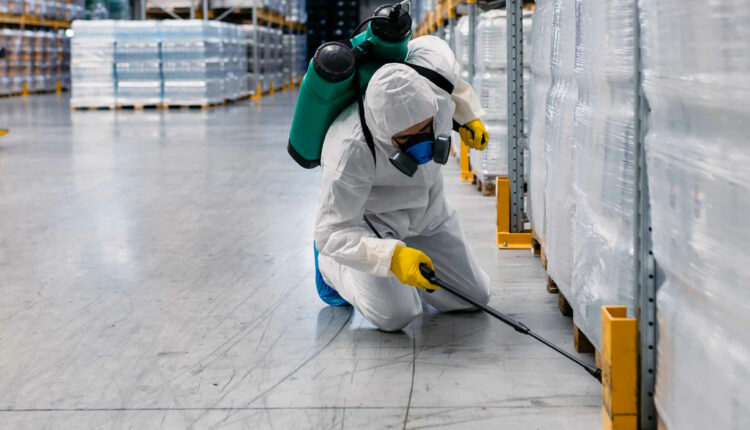Insect and pest control in the food plant requires a comprehensive strategy to ensure product quality and safety.
Before talking about the documents required from the pest control company when contracting a food factory, let’s generally address the pest and insect control plan within a food factory.
The plan to control pests and insects within a plant or food establishment is based on a range of preventive measures and traditional remedies that can be implemented without the need for advanced technology.
In this article, we will discuss effective and available ways to achieve this goal first.
Traditional steps to control insects and pests
1. Cleaning
– Periodic cleaning:
A day-to-day cleaning programme should be implemented that includes cleaning floors, roofs, machines and surrounding areas.
– Use of traditional disinfectants: use of natural disinfectants, such as vinegar and water solutions or reduced chlorine solutions for sensitive areas.
2. Environmental control
– Maintenance of construction:
Repair of any incisions or gaps in walls, doors and windows to prevent the entry of insects.
– Good storage:
Storage of raw materials and end products in sealed containers and in clean and dry areas.
3. Waste management
– Regular disposal of wastes:
Regular collection and transport of wastes to prevent their accumulation and attract insects and pests.
– Use of closed containers: use of sealed waste containers and ensure that they are regularly cleaned.
4. Biocontrol
– Smart use of natural enemies:
If appropriate and safe, natural enemies like cats can be used to fight rodents.
5. Good ventilation.
– Improvement of ventilation:
Ensuring a good ventilation at the plant can reduce moisture, which is considered an ideal breeding environment for insects.
6. Awareness-raising and training
– Training of personnel:
Sensitize staff to the importance of hygiene, simple preventive procedures and their roles in pest control.
– Immediate notification:
Encourage workers to report immediately any signs of insects or pests.
Comprehensive plan to control insects and pests within a food factory
1. Comprehensive assessment
– Location analysis:
Comprehensive assessment of the surrounding areas of the plant and identification of vulnerable points that may be an entry point for insects.
Initial examinations:
Regular screening for the early presence of insects or pests.
2. Implementation
– Implementation of preventive measures: development of a comprehensive system of efficient cleaning, maintenance and storage of materials.
– Cleaning schedule:
A timetable has been drawn up that includes weekly, monthly and quarterly cleaning tasks.
3. Monitoring and follow-up
Periodic examinations
Conduct periodic check-ups to verify that there are no signs of insects or pests.
– Control records:
Maintain accurate records of all maintenance, cleaning and insect detection activities.
4. Corrective action
– Immediate intervention:
When any insects are detected, immediate action such as deep cleaning or the use of natural insecticides must be taken.
– Review of the plan:
Periodic evaluation and updating of the implementation plan based on developments and needs.
Conclusion
Maintaining an insect- and pest-free food factory requires rigorous traditional strategies and daily practices to which all team members are committed. Using traditional preventive measures and treatment, a safe and clean environment can be achieved that ensures the quality and safety of food products.
Control of public health pests in food factories is crucial given the sensitivity of these sites. These processes require major challenges such as spraying and fixing of bait stations, with a constant focus on product safety for consumers.
Strict standards and controls are imposed by the regulatory and governmental authorities responsible for food safety and the control of public health ills on these factories and food institutions.
To ensure compliance and effectiveness, pest control companies must provide and regularly update many of the necessary documentation at the end of their useful life, when contracting a food factory.
Documents required from the Insect Control Company when contracting a food factory:
1. Commercial licence of the Insect Control Company (in force).
2. Tax registration certificate.
3. Follow-up card visits, to ensure regular attendance at the site in accordance with municipal requirements.
4. Service reports, including details of visit and pest control procedures, materials used, recommendations for cleaning or maintenance, and finally safety instructions.
5. Pest control map shows the location and number of surveillance and control stations, whether cockroache surveillance fisheries, rodent adhesives, flying insect optical fisheries, or rodent bait stations installed abroad.
6. Report on the level of periodic pests (Trend Analysis).
7. Certificates of registration of pesticides used on site.
8. Chemical safety certificates for on-site pesticides (MSDS).
9. Accreditation cards for engineers, supervisors and technicians from the competent government agencies (licences for the exercise of their public health pest control profession).
These documents ensure compliance with standards and controls, thereby contributing to a safe and pest-free environment in food factories, thereby enhancing product safety and consumer protection.

